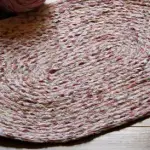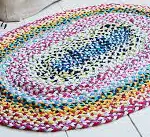
If you want to create a braided rug, you need to know how to make one with different shapes and materials. The shapes and materials you use will depend on the size and shape of your rug. You can make a round or oval rug by making long continuous braids. You can also make a rag rug using denim.
Tip for braiding a rug
When braiding a rug, you must use a loose knot, otherwise, the strands will be too tight and can cause lumps. Ensure the braid is long enough to cover the entire rug without creating lumps. To prevent the rug from bunching up, spritz it with water before braiding, and keep a heavy object underneath it while you braid.
The fabric strips you use should be different lengths to make braiding easier. Also, it’s important to make sure that they are clean and free of frayed strings. Once you’ve cut and pinned the fabric strips together, start braiding them. Make sure to overlap the ends by 3 inches. Then, use a safety pin or similar object to create tension in the braid.
Materials for braided rugs
Braided rugs are made by weaving together strips of fabric. Commonly made of wool or cotton, these rugs are versatile and can vary in thickness and shape. Wool braided rugs can be warm and inviting in an informal room. A well-made wool braided rug is firm and will lie flat on the floor. It also resists dirt and moisture.
You can find materials for braided rugs at yard sales, thrift stores, or flea markets. Alternatively, you can even create one at home by going through old items in your attic. Regardless of the size and material, you’ll want to use durable yarn in order to make sure the rug will last.
Shapes of braided rugs
Braided rugs are woven pieces of fabric that can come in various colors and patterns. They are also made to showcase elaborate designs and are useful for all rooms. These rugs are made of durable materials that can last for many years. They can also be passed down through the family for generations.
Braided rugs were originally made in oval and round shapes and were made from mixed fabrics. The originals were sewn together with thread. In the 1930s, a method called “lacing” was developed and it is still used today. This method allows the braids to be put together in different shapes.
Braided rugs can be woven by hand or by sewing. They can be made from any materials, including wool. The process is simple. The first strip determines the size of the rug, and the rest of the strips are the same length. The center string should be about one-third of the total length. Once all the strips are braided together, they are sewn together to form the final shape.
Using denim for braided rag rug
You can make a braided rag rug using denim. Begin by folding one jean leg in half lengthwise and pinning the folded end one inch from the canvas edge. Then, crochet over the folded end once or twice onto the row below. Continue to do this for all four sides of the rug, joining the ends together with a quarter-inch seam on each. Then, alternate the joins to create stripes or a gradient effect. If you want the rug to be safe, you can also add a non-slip backing to it.
You can make the braided rag rug any size, but remember that larger rugs require more denim. To avoid running out of denim, consider purchasing more denim strips at a thrift store or borrowing old ones from friends and family. Alternatively, you can use old jeans to make a denim doormat.
Using fabric scraps for braided rag rug
If you have old clothes and fabric scraps, you can turn them into braided rugs. You’ll need basic sewing and braiding skills to create a rug of any size. You’ll also need a thick needle, a thick crochet cotton thread, or buttonhole twist thread. You can use cotton cording if you don’t have any of these materials.
The first step to making a braided rag rug is to select three strands of fabric and begin to braid. You can do this by hand or with a sewing machine. Work the strands together for about a foot. When you’re finished, bend the fourth strand in half, go under/over, and sew it to the other three strands.






